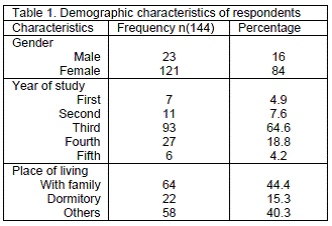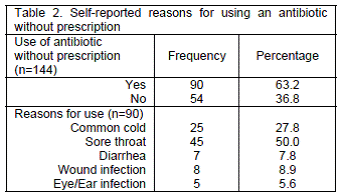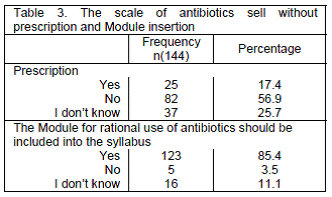Mi SciELO
Servicios Personalizados
Revista
Articulo
Indicadores
-
 Citado por SciELO
Citado por SciELO -
 Accesos
Accesos
Links relacionados
-
 Citado por Google
Citado por Google -
 Similares en
SciELO
Similares en
SciELO -
 Similares en Google
Similares en Google
Compartir
Pharmacy Practice (Granada)
versión On-line ISSN 1886-3655versión impresa ISSN 1885-642X
Pharmacy Pract (Granada) vol.14 no.1 Redondela ene./mar. 2016
https://dx.doi.org/10.18549/PharmPract.2016.01.715
ORIGINAL RESEARCH
Pharmacy students’ knowledge and attitudes about antibiotics in Kosovo
Albina Fejza1, Zeqir Kryeziu2, Kushtrim Kadrija3, Malbora Musa4
1 BPharm. Department of Pharmacy, Medical Faculty, University of Prishtina. Prishtina (Kosovo). albinafejza@gmail.com
2 BPharm. Department of Pharmacy, Medical Faculty, University of Prishtina. Prishtina (Kosovo). zkryeziu@hotmail.com
3 Department of Dentistry, Medical Faculty, University of Prishtina. Prishtina (Kosovo). kushtrimkadria94@gmail.com
4 MPharm. Assistant Professor. Department of Pharmacy, Medical Faculty, University of Prishtina. Prishtina (Kosovo). malboram@gmail.com
ABSTRACT
Objective: The main objective of this study was to assess the knowledge and attitude among Pharmacy students of the University of Prishtina in regards to the antibiotics.
Methods: 144 pharmacy students at the University of Prishtina were recruited in this study to complete a self-administered questionnaire. The total number of questions in this questionnaire was eight (8), covering two (2) major themes: self-report of the current and past antibiotic use and behavior; and anticipated prescription behavior of antibiotics upon graduation. The data was statistically analyzed through using SPSS for Windows. Descriptive analysis was employed, and the results were expressed in frequency and percentages.
Results: The results showcased a good knowledge of antibiotic among students. The most common answer of students' knowledge about antibiotics was good or moderate (82 %), while 63.2% of the subjects used antibiotics by self-decision, most of them (45 %) for sore throat. Upon graduation, 56.9 % of the students will not sell antibiotics without prescription and 85.4% think that module for rational use of antibiotics is very necessary to be inside the pharmacy syllabus.
Conclusion: The study showed good and moderate knowledge of pharmacy students regarding the antibiotics. Half of them use antibiotics by self-decision but the majority of them stated that they will not serve the antibiotics without medical prescription. Specific modules and training for proper antibiotic use should be implemented within the Pharmacy program in The Faculty of Medicine.
Key words: Students, Pharmacy; Health Knowledge, Attitudes, Practice; Anti-Bacterial Agents; Kosovo.
Introduction
Antibiotics were discovered about eight decades ago and since then, there has been a revolution in the management, treatment and outcome of infectious disease. Therefore antibiotics are one of the most commonly prescribed, sold and used drugs worldwide. They are used at wrong doses, for wrong indications, at wrong dosing intervals and for too long or inadequate length of time.1 World Health Organization (WHO) has reported an increase of the antibiotic resistance worldwide. Antibiotics resistance is a major public health threat worldwide.2 In many developing countries such as the Republic of Kosovo, antibiotics are sold even without prescription of doctors and are used in an inappropriate way. This leads to an increased number of antibiotic resistances in our country as well as in the others. Studies from the American, Asian and European countries indicate that between 22% and 70% of parents have misconceptions about the appropriate applications and efficacy of antibiotics and often use them without a prescription.3 One of the key areas in the control of antibiotic resistance is a change in the behavior of consumers and providers of antibiotics.1
Faculty of Medicine at the University of Prishtina includes Pharmacy, Dentistry and Nursing Departments. Pharmacy has a five-year degree program and students after receiving their degree, they get the right of working or having their own Pharmacy or Drug Store. Considering this, their knowledge attitude and behavior in relation to public usage of the antibiotics can have a great impact in the future on antibiotic-related issue in Kosovo. Therefore, we as students of pharmacy, having background knowledge about the misuse of the antibiotics in our country, in collaboration with our mentor, are seeking to conduct a research on this issue, by hoping to shed some light on the overall usage of antibiotics in the contemporary times as well as after the graduation.
The aim of this study was therefore, to examine the knowledge and attitude about antibiotics among students in the University of Prishtina, Kosovo.
Methods
A cross-sectional study was carried out among the 144 students of pharmacy at the University of Prishtina during the period March-July, 2015.The participation of students in this study was voluntary, and the students were informed that the completion and submission of the questionnaire would be taken as their consent to participate in this study. A high level of confidentiality and anonymity was maintained throughout the study.
The self - administered questionnaire had a total number of eight questions, covering two major themes.
The first part included self-report of current and past antibiotic use and behavior, while the second part contained information about antibiotics prescription behavior after the students of Pharmacy graduate. The questionnaire itself was structured, close-ended with ordinal-polytomus response.
The data was statistically analyzed using SPSS 20 for Windows. Descriptive analysis was applied, and the results were expressed in frequency and percentages. Chi-squares test was used to assess the association between the variables. p<0.05 was considered as a significant association.
Results
A total of 144 students participated in this study. The results showed a good knowledge of the antibiotic use among pharmacy students. The majority of respondents (84%) were female, out of which 93 (64.3 %) are in the third year of their studies. Most of them (44.4 %) live with their families while only 15.3% live in the dormitory, (Table 1).
Participants showed a good (44.4%) and a moderate (37.5%) knowledge of prescription, its usage and the side effects of the antibiotics. Only 2.8% of them have showed a limited knowledge.
Pharmacy students used the antibiotics without prescription in 63.2% of cases. The main reason for antibiotics use was due to the sore throat (50%), followed by common cold (27.8%). We analyzed the correlation between the use of antibiotics without prescription and respondents’ the living place, the year of study and gender however, the findings were not statistically significant (Table 2).
The participants were asked regarding their attitude towards the antibiotics and a module for antibiotic rational use upon graduation. The highest number (n=82) of participants explained the fact that they were not going to sell antibiotics without prescription once they start to practice their duty, while 25 students said they will sell the antibiotics even without prescription. There was no difference between gender, year of study or living place and antibiotics sell upon graduation (p>0.05).
Having in mind that in our study syllabus there is no program or module as such for rational use of the antibiotics, the authors asked the participants for their opinion about this issue. The majority of them (85.4%) showed the interest for the module insertion into the program of the Pharmacy Department within the University of Prishtina. The authors of this study also checked for any significant difference between demographic components but the p value was higher than 0.005%, (Table 3).
Discussion
This study analyzed the knowledge and attitudes of the antibiotics among Pharmacy students in the Public University in Prishtina, Kosovo. This is the first study that has ever taken place in examining the antibiotic usage among pharmacy students in our University. The research showed that the knowledge of the students about the antibiotics is above the expected because more than the 2/3 declared to have a good or an excellent knowledge. However, this is not in accordance with the real practice of the antibiotics use since regardless of their knowledge, yet a high number of the respondents used antibiotics without prescription. From our perspective, this is a lack of a proper medical education in the current and previous levels of education as along with a bad practice of antibiotic use in our country in general. Those results are in line with other published studies which also reported good understanding of the antibiotics among healthcare students.4 In the study of Kumara et al is concluded that the knowledge towards antibiotics among the nursing students in MUCH (Master skill University College of Health Sciences) is less than average, compared to our results which are good or outstanding. This highlights the immediate need for educational strategies to be further developed which would enable students to reflect on the antibiotics knowledge.5 A study conducted in Jordan showed that the knowledge of when antibiotics should be used, the efficacy of the antibiotics as well as the risk of the antibiotic resistance is inadequate since 47.3% of participants illustrated <50% correct response.6 A study by Liang, Miaoyin showed that 67.6 % of the questionnaire respondents possess the correct knowledge of the proper use of antibiotics.2 Undergraduate students had inadequate knowledge, moderately accurate beliefs and inappropriate practices concerning the antibiotics, along with a high rate of self-medication.7 A Nigerian study found out that pharmacy students had many leftover antibiotics, indicating the development of antibiotic resistance due to either medication non-adherence or inappropriate antibiotic usage.4
An Australian study showed that over a third of the 252 participants believed that they would recover faster by taking antibiotics when suffering from a cold or flu, and nearly one-fifth felt that the antibiotics would cure viral infections.8 While in our study half of the respondents claimed to have used antibiotics for sore throat. Comparison of our results to those obtained from this study and having in mind that sore throat and common cold are probably viral infections, we came to the conclusion that despite the good knowledge about antibiotics, incorrect behaviors were still noticed.
Common cold was also the main reason in the study by Ahmad et al. Kumara et al. found out that 75.6% of students understand that antibiotics can cure the disease because it is given as prophylaxis to cure from the disease. Only 25.6% of students agreed that antibiotics are not necessary for mild disease because it may lead to antibiotic resistance and difficulties some further infection. In New Zealand where health education and legal framework are at a very high level, the antibiotics prescription written by a health professional is by far the most common source of previously used antibiotics: 86% reported that antibiotics were prescribed by their doctors, and 10% by dentists. Very few respondents reported other sources, such as pharmacies without prescription, stored at home or family and friends.9 Meanwhile in Trinidad and Tobago, one in five of the respondents in a survey obtained their antibiotics as over-the-counter medications at private pharmacies without a doctor’s prescription, while another survey in Hong Kong demonstrated that 9% of participants obtained antibiotics without any prescription.10 A researcher named Mir, found out that the influence of the medical curriculum on students’ knowledge, attitude and practice regarding the use of the antibiotics at different semester/year, improved as they progressed in their study attaining the highest scores at third professional level.11 A study conducted with 2500 Chinese students indicates that Chinese medical curriculum significantly improves students’ knowledge on the antibiotics and increases their awareness on the antibiotics resistance which may derive from an indiscriminate use of antibiotics.12
A European Union research project in Kosovo which was carried out last year (in the year 2015), aimed to gather data which would serve as a tool for quality improvement in Kosovo and would support the preparation of guidelines and protocols for prudent use of antibiotics.13 Portuguese pharmacists perceive that the antibiotics use and bacterial resistance could be improved, showing a behavioral intention to improve antibiotic dispensing habits.14 Scaioli et al. form the University of Turin, found out that it was essential to create more awareness on this topic during the degree courses as the health professional students will be a behavioral model for citizens and patients, It would be advisable to introduce specific course and training about the importance of correct the antibiotics consumption in the European core curriculum of the School of Medicine.15 Our study also showed that 85.4% expressed the interest for a specific module for a proper antibiotic use insertion into the program of the Department of Pharmacy in the University of Prishtina.
Conclusions
The study showed a good and a moderate knowledge of pharmacy students regarding the antibiotics however, despite of the theoretical results, they still have an incorrect behaviors concerning the antibiotics consumption. The pharmacy students will be a behavioral model for citizens and patients, it is essential to raise the awareness on this topic during the degree courses. Having this in mind, implementation of a specific module and training for a proper usage of the antibiotics in the Pharmacy Department of the Faculty of Medicine would be worth considering.
Conflict of interest
Nill.
References
1. Igbeneghu OA. Knowledge and practices in the use of antibiotics. Int J Infect Control 2013;9(1):10539. doi: 10.3396/ijic.v9i1.10539. [ Links ]
2. Liang M. Medical students' attitude towards antibiotics misuse in Hong Kong, Master Thesis. University of Hong Kong, 2012. [ Links ]
3. Togoobaatar G, Ikeda N, Ali M, Sonomjamts M, Dashdemberel S, Mori R, Shibuya K. Survey of non-prescribed use of antibiotics for children in an urban community in Mongolia. Bull World Health Organ. 2010;88(12):930-936. doi: 10.2471/BLT.10.079004. [ Links ]
4. Ahmad A, Khan MU, Moorthy J, Jamshed SQ, Patel I. Comparison of knowledge and attitudes about antibiotics and resistance, and antibiotics self-practicing between Bachelor of Pharmacy and Doctor of Pharmacy students in Southern India. Pharm Pract (Granada). 2015;13(1):523 doi: 10.18549/PharmPract.2015.01.523. [ Links ]
5. Satish K, Santhosh Yl, Ahamed MG, Naveen MR. Survey on knowledge towards antibiotics among the nursing students. Int J Pharm Pharm Sci. 2011;3(2):227229. [ Links ]
6. Shehadeh M, Suaifan G, Darwish RM, Wazaify M, Zaru L, Alja'fari S. Knowledge, attitudes and behavior regarding antibiotics use and misuse among adults in the community of Jordan. A pilot study, Saudi Pharm J. 2012;20(2):125-133. doi: 10.1016/j.jsps.2011.11.005. [ Links ]
7. Lv B, Zhou Z, Xu G, Yang D, Wu L, Shen Q, Jiang M, Wang X, Zhao G, Yang S, Fang Y. Knowledge, attitudes and practices concerning self-medication with antibiotics among university students in western China. Trop Med Int Health. 2014;19(7):769-779. doi: 10.1111/tmi.12322. [ Links ]
8. Fredericks I, Hollingworth S, Pudmenzky A, Rossato L, Syed S, Kairuz T. Consumer knowledge and perceptions about antibiotics and upper respiratory tract infections in a community pharmacy. Int J Clin Pharm. 2015;37(6):1213-1221. doi: 10.1007/s11096-015-0188-y. [ Links ]
9. Norris P, Chong CE, Chou A, Hsu TH, Lee CC, Kuei-Lien Su C, Wang Y. Knowledge and reported use of antibiotics amongst school-teachers in New Zealand. Pharm Pract (Granada). 2009;7(4):238-241. [ Links ]
10. Ling Oh A, Hassali MA, Al-Haddad MS, Syed Sulaiman SA, Shafie AA, Awaisu A. Public knowledge and attitudes towards antibiotic usage: a cross-sectional study among the general public in the state of Penang, Malaysia. J Infect Dev Ctries. 2011;5(5):338-347. [ Links ]
11. Mir SA. A cross-sectional study on knowledge, attitude, and behavior related to antibiotic use among undergraduate medical students in a tertiary care medical college, Kashmir. Int J Basic Clin Pharmacol. 2015;4(6):1156-1162. doi: 10.18203/2319-2003.ijbcp20151351. [ Links ]
12. Huang Y, Gu J, Zhang M, Ren Z, Yang W, Chen Y, Fu Y, Chen X, Cals JW, Zhang F. Knowledge, attitude and practice of antibiotics: a questionnaire study among 2500 Chinese students. BMC Med Educ. 2013;13:163. doi: 10.1186/1472-6920-13-163. [ Links ]
13. Raka L, Goosens H, Mulliqi G, Versporten A, Krasniqi S, Kostyanev T, Kurti A, Lammens C, Kurti A, Paasch F, Uka V, Jakupi A, Loku A, Raka D. “Capacity building to implement state of the art surveillance systems for antibiotic consumption and resistance in kosovo”: results of European Union research project in Kosovo. Antimicrob Resist Infect Control. 2015; 4(Suppl 1): P178. 10.1186/2047-2994-4-S1-P178. [ Links ]
14. Roque F, Soares S, Breitenfeld L, López-Durán A, Figueiras A, Herdeiro MT. Attitudes of community pharmacists to antibiotic dispensing and microbial resistance: a qualitative study in Portugal. Int J Clin Pharm. 2013;35(3):417-424. doi: 10.1007/s11096-013-9753-4. [ Links ]
15. Scaioli G, Gualano MR, Gili R, Masucci S, Bert F, Siliquini R. Antibiotic Use: A Cross-Sectional Survey Assessing the Knowledge, Attitudes and Practices amongst Students of a School of Medicine in Italy. PLoS One. 2015;10(4):e0122476. doi: 10.1371/journal.pone.0122476. [ Links ]
Received (first version): 04.01.16
Accepted: 06.03.16

















